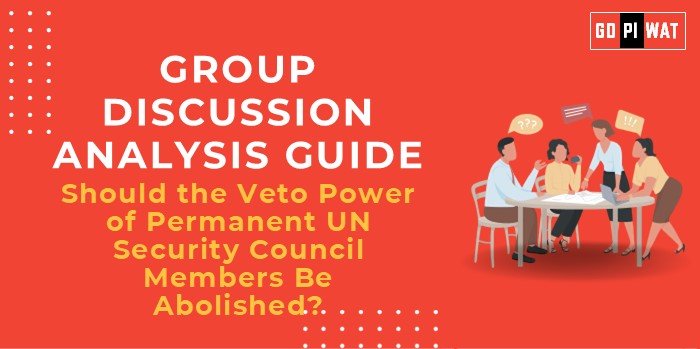📋 Group Discussion (GD) Analysis Guide: Should the Veto Power of Permanent UN Security Council Members Be Abolished?
🌐 Introduction to the Topic
- 📌 Opening Context: The United Nations Security Council (UNSC) has served as a cornerstone for international peace and security since 1945. However, the veto power of its five permanent members (USA, UK, France, China, and Russia) often sparks debates about its fairness and effectiveness.
- 📖 Topic Background: The veto power was introduced to ensure the participation of great powers in the UNSC. Critics argue it has led to paralysis in conflict resolution, such as during the Syrian Civil War and Russia-Ukraine conflict.
📊 Quick Facts and Key Statistics
🌍 UN Member States: 193 members, only 5 with veto power.
🛡️ Recent Veto Usage: Russia vetoed a UNSC resolution on Ukraine (2022).
💰 UN Budget Contribution: P5 members contribute over 45% of the UN budget.
🌐 Global Sentiment: 75% of countries in a 2023 UN survey supported veto reform.
🛡️ Recent Veto Usage: Russia vetoed a UNSC resolution on Ukraine (2022).
💰 UN Budget Contribution: P5 members contribute over 45% of the UN budget.
🌐 Global Sentiment: 75% of countries in a 2023 UN survey supported veto reform.
👥 Stakeholders and Their Roles
- 🏛️ Permanent Members (P5): Exercise veto power to safeguard national interests.
- 🌍 General Assembly Members: Advocate for equal representation.
- 🌱 Civil Societies & NGOs: Push for accountability and reforms.
- 📈 International Organizations: Promote global peace and cooperation.
🏆 Achievements and Challenges
✨ Achievements:
- 🛑 Conflict Prevention: UNSC has resolved disputes, e.g., during the Cuban Missile Crisis.
- 🤝 Humanitarian Aid: Enabled interventions in crises like Darfur.
- 🌍 Peacekeeping Missions: Over 70 successful missions globally.
⚠️ Challenges:
- 📉 Paralysis in Decision-Making: Over 250 vetoes have blocked resolutions since 1945.
- ⚖️ Bias Towards P5 Interests: Often prioritizes their geopolitical agendas.
- 🌐 Lack of Representation: Excludes voices of emerging powers and regions.
🌍 Global Comparisons:
- ✔️ NATO: Decisions by consensus but criticized for exclusion of non-members.
- ✔️ EU: Majority voting for policy adoption promotes inclusivity.
Case Studies:
- 🇺🇦 Russia-Ukraine Crisis: Russian veto blocked resolutions condemning its actions.
- 🇸🇾 Syrian Civil War: Multiple vetoes by Russia and China prevented intervention.
📢 Structured Arguments for Discussion
- ✅ Supporting Stance: “Abolishing the veto ensures equitable decision-making in global conflicts.”
- ❌ Opposing Stance: “Without veto power, major powers may disengage from UNSC, undermining its authority.”
- ⚖️ Balanced Perspective: “Reforming veto usage—rather than abolishing it—could balance fairness with functionality.”
🧠 Effective Discussion Approaches
- 🎯 Opening Approaches:
- “The veto system reflects post-WWII power dynamics, but is it suitable for today’s multipolar world?”
- “Given the failures in Syria and Ukraine, can veto reform reinvigorate the UNSC?”
- 🤝 Counter-Argument Handling:
- Highlight potential disengagement of P5 if veto is removed.
- Discuss successful compromises like the French proposal for veto restraint in cases of mass atrocities.
📊 Strategic Analysis of Strengths and Weaknesses
- 🌟 Strengths: Maintains great power engagement, prevents rash decisions.
- ⚠️ Weaknesses: Undemocratic, fosters inaction during crises.
- 📈 Opportunities: Veto reform could increase global trust.
- ⚡ Threats: Abolition risks losing P5 participation.
🎓 Connecting with B-School Applications
- 💼 Real-World Applications: Models for decision-making in organizations, lessons in conflict resolution.
- 📚 Sample Interview Questions:
- “Should B-schools adopt veto-like mechanisms for team decision-making?”
- “How can veto reform inform international business strategies?”
- 💡 Insights for Students:
- Understand global governance structures and their implications for geopolitics and business.


